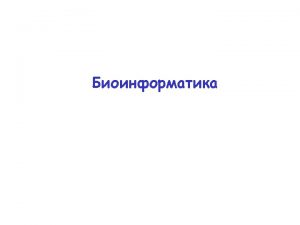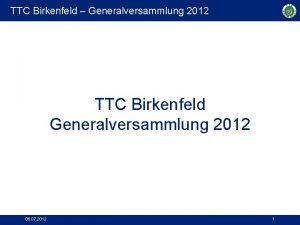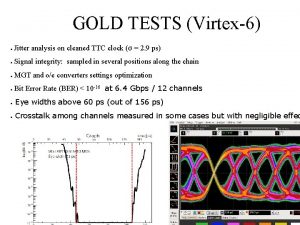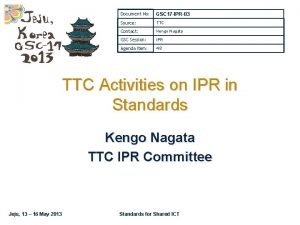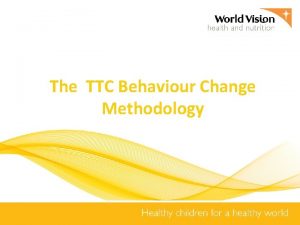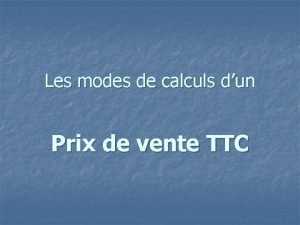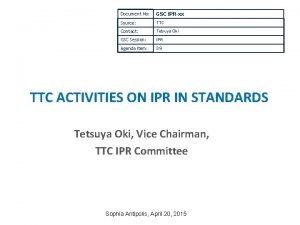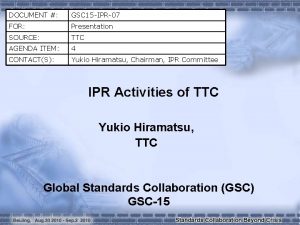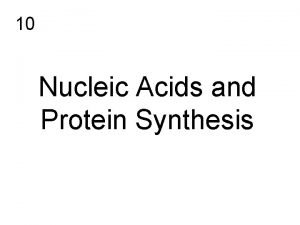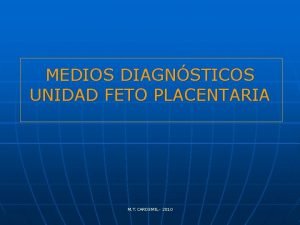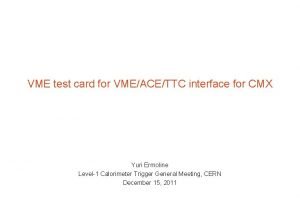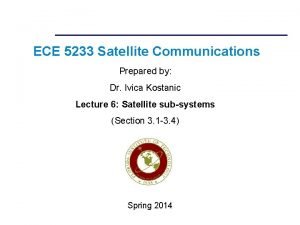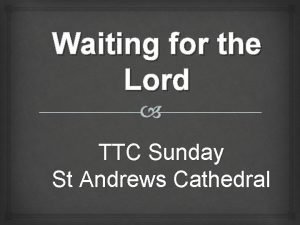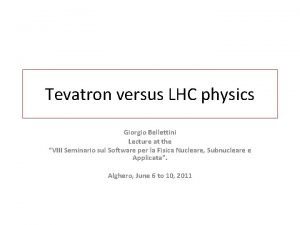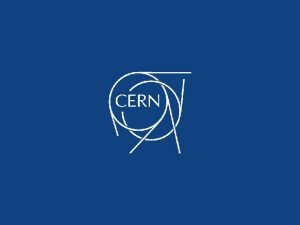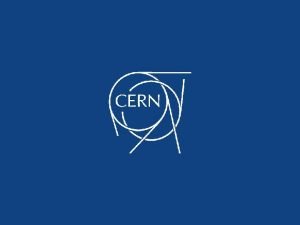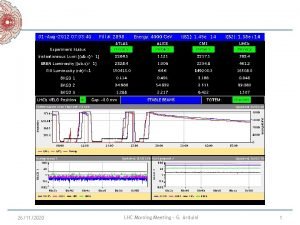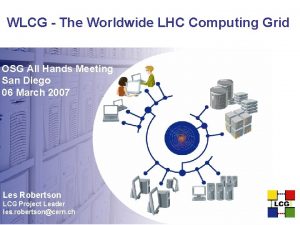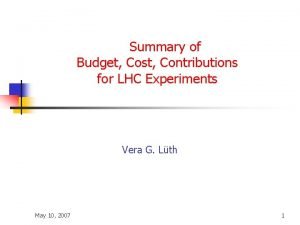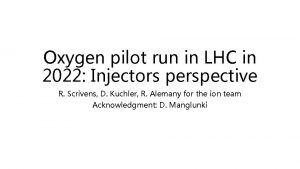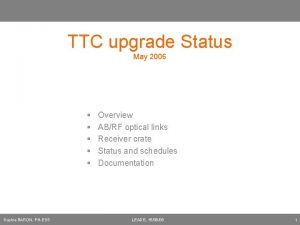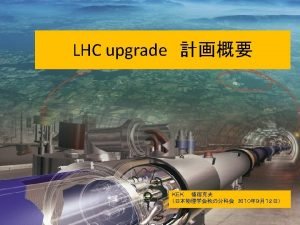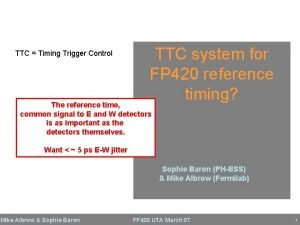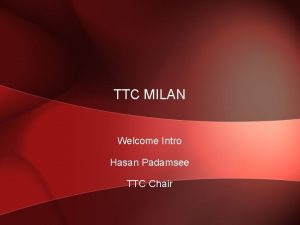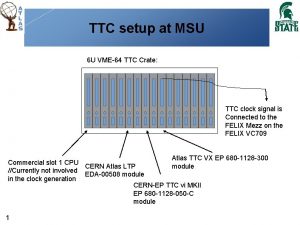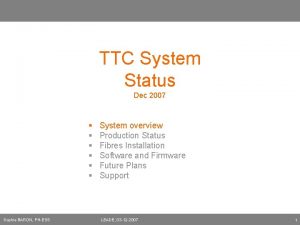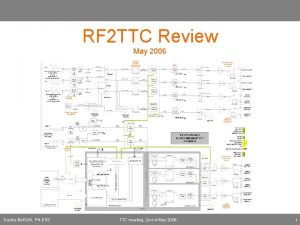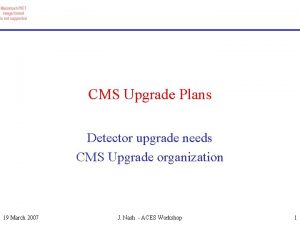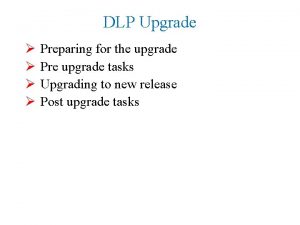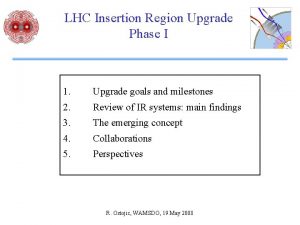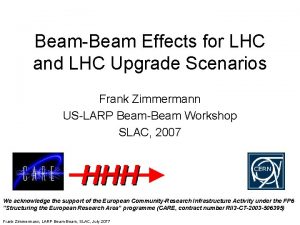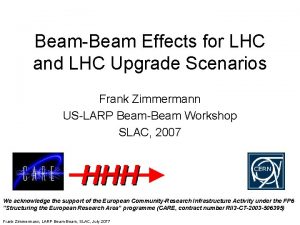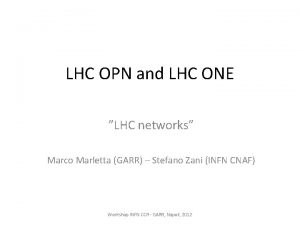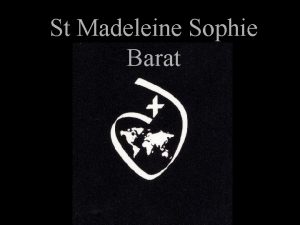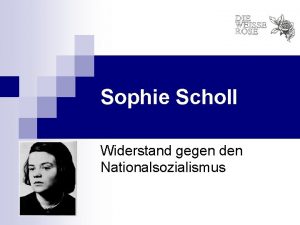TTC Challenges and Upgrade for the LHC Sophie




















![Conclusions n n n The current system will be difficult [impossible] to maintain and Conclusions n n n The current system will be difficult [impossible] to maintain and](https://slidetodoc.com/presentation_image_h2/8f225abd423c5ef106036921c671c966/image-21.jpg)
- Slides: 21

TTC Challenges and Upgrade for the LHC Sophie BARON LECC workshop – Heidelberg – September 2005 Sophie BARON LECC Workshop - Heidelberg - September 2005

Outline TTC System overview Current system challenges System upgrade for 2007 Practical implementation Sophie BARON LECC Workshop - Heidelberg - September 2005 2

TTC: Timing, Trigger and Control A complete system designed by B. Taylor between 1990 and 2000, now retired. Transmission of… n Timing of the LHC from the RF source to the experiments q LHC Bunch Clock (40. 078 xx MHz) q Revolution Frequency (11. 245 x k. Hz) Then combined in the experiments with … n Trigger and Control signals …Usingle optical fibres. Sophie BARON LECC Workshop - Heidelberg - September 2005 3

Current system overview 1 Transmission principle n Time Division Multiplexing + Bi. Phase Mark encoding at 160. 32 MBauds of 2 channels: q A-channel: n q Low-latency signals B-channel: n n Framed and formatted commands and data, Broadcast and individually-addressed, Forward error-correction for high reliability, Frames of 16 or 42 bits. A: Revolution Frequency B: idle A: Level-1 trigger B: Control & Command signals Sophie BARON LECC Workshop - Heidelberg - September 2005 4

Current system overview 2 Global network SR 4 -CCC • Optical transmission of BC and Frev • Ensured by the AB/RF group CCC • Frev synchronisation => Orbit • BC & Orbit selection (LHC/SPS/Internal) • Signals encoding • Broadcast to experiments via high power lasers CCC-Experiments Optical transmission of BC and Orbit Experiments • Reception and decoding of the signals – Bunch Clock recovery • Integration of the trigger and control signals • Encoding, optical transmission and broadcast of the completed signals • Reception and decoding of the information see next slide Sophie BARON LECC Workshop - Heidelberg - September 2005 5

Current system overview 3 Inside the experiments TTCmi: • Reception and decoding of the BC & orbit • One TTCmi crate for each ring (2/experiment) Central Trigger Processing PARTITION • Local trigger processing • Integration of the trigger and control signals at the partition level (A and B channel preparation) • Specific to each experiment Encoding of A and B channels, optical transmission and broadcast: • TTCex, • TTCtx, • TTCoc Reception and decoding of the information: • TTCrx & QPLL chips • TTCrq mezzanine Sophie BARON LECC Workshop - Heidelberg - September 2005 6

Production status TTCex: 200 pieces. Status: Produced. Last batch is currently being tested. Available end of September. TTCtx: Status: 50 pieces. Available. TTCoc: Changes: 200 pieces. Single Mode splitters instead of the initial multimode to solve problems of uniformity. Available. Status: TTCrq: Last version: Changes: 2300 pieces. TTCrq-V 5. Passive network added to limit the power in the quartz (avoid activity dips). Status: Produced. Last 20% are currently being tested. Available end of September. Sophie BARON LECC Workshop - Heidelberg - September 2005 7

TTC System overview Current system challenges System upgrade for 2007 Practical implementation Sophie BARON LECC Workshop - Heidelberg - September 2005 8

Increasing number of BCs n The 3 RF frequencies of the LHC: n n n ring 1 ring 2 n Generated at SR 4 (Echenevex) 1 RF per ring, At the flat top, the 2 RF will be synchronised to the same reference frequency, This reference frequency will be delivered by a generator and fixed for each run. Þ 3 Bunch Clocks are available (and thus required by the experiments), as well as the orbit of each ring, [only 2 BC were foreseen in the previous scheme] Sophie BARON LECC Workshop - Heidelberg - September 2005 9

BC Guaranteed periods Example for a proton-proton cycle RF frequencies (MHz) Beam Dump 400. 78966 RF reference (Lead Ions: 400. 78406 MHz) 400. 78879 time injection ~15 min n ramping ~28 min squeeze ~15 min physics ~10 -20 H Guaranteed timing signals The TTC has to supply a fake 40. 078 xx MHz clock – and orbit – to the experiments outside these periods, q q n E(4 50 Ge V- >7 Te ng 1 a RF ri 400. 78922 V) nd 2 (Lead Ions: 400. 78964 MHz) switch to the LHC Bunch Clock at injection, switch back at beam dump, Use the machine modes transmitted by the BST system to the experiments using parallel optical fibres Sophie BARON LECC Workshop - Heidelberg - September 2005 10

Maintenance & support 1 n Situation at the CCC q The number of TTC transmission crates (in CCC) is limited: n n q Maintenance is complicated: n n q 3 crates are required to match the need of 3 BCs Only 4 complete systems are available Components are ageing and are obsolete Design sources are missing On-call support can not be guaranteed: n n Sophie BARON No remote monitoring No team for the on-call support LECC Workshop - Heidelberg - September 2005 11

Maintenance & support 2 n Situation at the experiments q Same problem for the receiving crates (TTCmi) in experiments and labs: n Number limited: q q n Maintenance difficult: q n Same problems as for the transmitter crates No remote access: q q Sophie BARON Required: 12 crates (3 per experiment) Available: 12 crates ! (2 per experiments + 4 for the machine and the support) Monitoring for support Control for clock source selection, global phase adjustment LECC Workshop - Heidelberg - September 2005 12

To summarize… n Maintenance of the current system difficult: q q n No on-call support: q q n No spares, Obsolete equipment. No team, No remote control. The current system does not fully match the new requirements: q q More transmitter and receiver crates are needed, New designs are needed to cope with the constraints. => Something needed to be done for 2007 Sophie BARON LECC Workshop - Heidelberg - September 2005 13

TTC System overview Current system challenges System upgrade for 2007 Practical implementation Sophie BARON LECC Workshop - Heidelberg - September 2005 14

Principle AB/RF transmitters BC 1, BC 2, BCref, Frev 1, Frev 2 AB/RF transmitters Optical links AB/RF receivers TTC transmitter crates Optical links AB/RF optical links TTC optical links n n TTCmi n n Sophie BARON New RF to TTC interface Presently under approval. . . Operation, maintenance & on-call support of the backbone ensured by the AB-RF operation and piquet teams, One interface to be redesigned, adding the missing functionalities (remote monitoring and control for clock switching and phase adjustment, The current system will remain in place until the new one is proved to be fully functional. LECC Workshop - Heidelberg - September 2005 15

What will & won’t change Experiments CCC TTC in Experiments BC & Orbit Replaced by Passive network of 6 fibres from SR 4 to the experiments – 3 BC, 2 Frev and 1 spare. Sophie BARON 2 AB/RF optical receiver modules 6 U VME crate RF 2 TTC interface Crate Controller LECC Workshop - Heidelberg - September 2005 See next slide 16

RF 2 TTC interface module n 6 U VME Module, designed to: q Receive the 3 BC and the 2 Frev signals from the AB/RF optical receivers and convert them into LVPECL: n n q BC: n n q Redirect them to various outputs – remote ctrl, Chose the BCs between LHC and internal – remote ctrl using the machine states (from BST), Adjust the phase of the BCs – remote ctrl, Cleans the BCs with a PLL, Frev: n n n q BC = 0 d. Bm sinusoidal signal, 40. 078 xx MHz frequency, Frev = 1 V peak pulse, 5 ns long, 88. 924 us period, Stretch them to an adjustable length – remote ctrl, Adjust the phase of the Frev – remote ctrl, Select the BC to synchronise them => Orbit – remote ctrl, Provide an internal orbit (counter) – remote ctrl, Redirect the Orbits to various outputs – remote ctrl, Monitor the state of the signals: n n n Sophie BARON PLL lock, Orbit, . . LECC Workshop - Heidelberg - September 2005 17

TTC System overview Current system challenges System upgrade for 2007 Practical implementation Sophie BARON LECC Workshop - Heidelberg - September 2005 18

Practical implementation n This upgrade involves many parties: q AB/RF group: n n q PH/ESS group: n n q Design and support of the BST transmission, TS/EL group: n q Coordination of the TTC project Specification and design the RF 2 TTC interface module, AB/CO and AB/BDI groups: n q Transmission of the RF timing signals from the SR 4 up to the experiments Full support & maintenance of this system, Fibre installation, ALICE, ATLAS, CMS and LHCb experiments: n Users of the TTC system …Still under approval [release expected (hoped) for end of September] Sophie BARON LECC Workshop - Heidelberg - September 2005 19

Milestones n 2005: q q n September: final agreement on this upgrade, October: finalise specification of the RF 2 TTC interface and beginning of the design, 2006: q q q January: reinstallation of the current system in the CCC, Spring: First RF 2 TTCprototype, Summer: -Installation of current and upgraded setups to prepare the structured test beams, -Software development, September: -Structured test beam, -New system validation, End of 2006: production of the RF 2 TTC and delivery of the AB/RF receivers to the experiments. Sophie BARON LECC Workshop - Heidelberg - September 2005 20
![Conclusions n n n The current system will be difficult impossible to maintain and Conclusions n n n The current system will be difficult [impossible] to maintain and](https://slidetodoc.com/presentation_image_h2/8f225abd423c5ef106036921c671c966/image-21.jpg)
Conclusions n n n The current system will be difficult [impossible] to maintain and support on the long term, Does not fully support the new requirements. A partial redesign is necessary and is on-going, This concerns only the part from SR 4 to experiments, The TTC system inside the experiments remains unchanged. Thanks to the AB/RF group and to the TTC coordinators for their help to set up this upgrade Sophie BARON LECC Workshop - Heidelberg - September 2005 21
 Ctc cta
Ctc cta Ttc birkenfeld
Ttc birkenfeld Ttc electrical aptitude test
Ttc electrical aptitude test Ttc organization chart
Ttc organization chart Ttc method
Ttc method Le taux de marque
Le taux de marque Ttc organization chart
Ttc organization chart Ttc organization chart
Ttc organization chart Look at the dna sequence gaa-ttc-gca
Look at the dna sequence gaa-ttc-gca Ttc obstetricia significado
Ttc obstetricia significado Vme test
Vme test Satellite communication system
Satellite communication system Ttc sunday service
Ttc sunday service Tevatron vs lhc
Tevatron vs lhc Lhc housing
Lhc housing Hl-lhc schedule
Hl-lhc schedule Uk hep forum
Uk hep forum Lhc logbook
Lhc logbook Lhc morning meeting
Lhc morning meeting Worldwide lhc computing grid
Worldwide lhc computing grid Lhc budget
Lhc budget Lhc schedule 2022
Lhc schedule 2022
